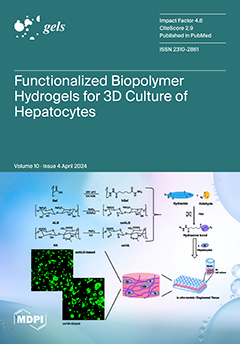In this study, we aimed to develop thermosensitive and bioadhesive in situ gelling systems containing solid dispersions of flurbiprofen (FB-SDs) using poloxamer 407 (P407) and 188 (P188) for ophthalmic delivery. FB-SDs were prepared with the melt method using P407, characterized by solubility, stability,
[...] Read more.
In this study, we aimed to develop thermosensitive and bioadhesive in situ gelling systems containing solid dispersions of flurbiprofen (FB-SDs) using poloxamer 407 (P407) and 188 (P188) for ophthalmic delivery. FB-SDs were prepared with the melt method using P407, characterized by solubility, stability, SEM, DSC, TGA, and XRD analyses. Various formulations of poloxamer mixtures and FB-SDs were prepared using the cold method and P407/P188 (15/26.5%), which gels between 32 and 35 °C, was selected to develop an ophthalmic in situ gelling system. Bioadhesive polymers Carbopol 934P (CP) or carboxymethyl cellulose (CMC) were added in three concentrations (0.2, 0.4, and 0.6% (
w/
w)). Gelation temperature and time, mechanical properties, flow properties, and viscosity values were determined. The in vitro release rate, release kinetics, and the release mechanism of flurbiprofen (FB) from the ophthalmic formulations were analyzed. The results showed that FB-SDs’ solubility in water increased 332-fold compared with FB. The oscillation study results indicated that increasing bioadhesive polymer concentrations decreased gelation temperature and time, and formulations containing CP gel at lower temperatures and in a shorter time. All formulations except F3 and F4 showed Newtonion flow under non-physiological conditions, while all formulations exhibited non-Newtonion pseudoplastic flow under physiological conditions. Viscosity values increased with an increase in bioadhesive polymer concertation at physiological conditions. Texture profile analysis (TPA) showed that CP-containing formulations had higher hardness, compressibility, and adhesiveness, and the gel structure of formulation F4, containing 0.6% CP, exhibited the greatest hardness, compressibility, and adhesiveness. In vitro drug release studies indicated that CP and CMC had no effect below 0.6% concentration. Kinetic evaluation favored first-order and Hixson–Crowell kinetic models. Release mechanism analysis showed that the
n values of the formulations were greater than 1 except for formulation F5, suggesting that FB might be released from the ophthalmic formulations by super case II type diffusion. When all the results of this study are evaluated, the in situ gelling formulations prepared with FB-SDs that contained P407/P188 (15/26.5%) and 0.2% CP or 0.2% CMC or 0.4 CMC% (F2, F5, and F6, respectively) could be promising formulations to prolong precorneal residence time and improve ocular bioavailability of FB.
Full article






